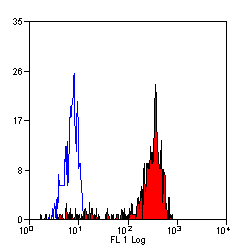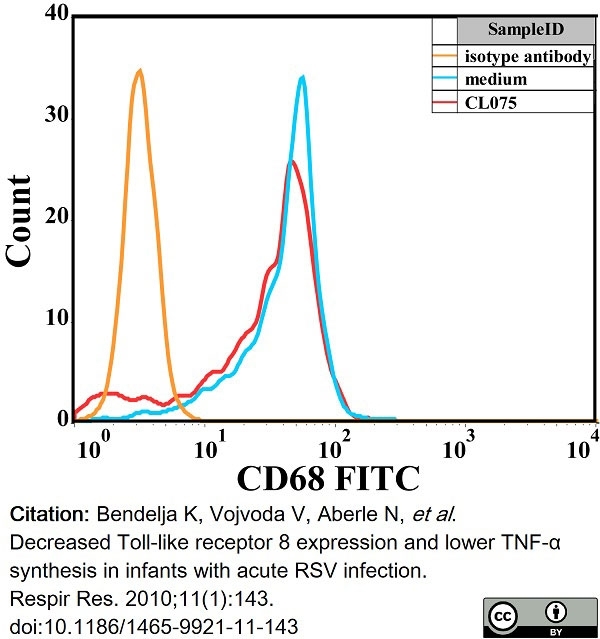CD68 antibody | Ki-M7


Mouse anti Human CD68:FITC
- Product Type
- Monoclonal Antibody
- Clone
- Ki-M7
- Isotype
- IgG1
- Specificity
- CD68
| Mouse anti Human CD68 antibody, clone Ki-M7 recognizes human CD68 an integral membrane glycoprotein of ~110 kDa also known as Macrosialin or Gp110. CD68 is predominantly expressed on the intracellular lysosomes of macrophages/monocytes, including Kupffer cells, microglia, histiocytes and osteoclasts, and is expressed to a lesser extent by dendritic cells and peripheral blood granulocytes. Elevated expression of CD68 has been demonstrated on CD34+ cells in various human malignancies, including Acute Myeloid Leukemia. In immunohistochemistry, CD68 can be used to aid in the identification of blastic NK lymphomas, some B cell lymphomas, and to help diagnose disorders relating to macrophage abnormalities, including malignant histocytosis and Gaucher’s disease. Clone Ki-M7 has also been reported as being suitable for use in immunoprecipitation. |
- Target Species
- Human
- Species Cross-Reactivity
-
Target Species Cross Reactivity African green monkey - N.B. Antibody reactivity and working conditions may vary between species.
- Product Form
- Purified IgG conjugated to Fluorescein Isothiocyanate Isomer 1 (FITC) - liquid
- Preparation
- Purified IgG prepared by affinity chromatography on Protein A from tissue culture supernatant
- Buffer Solution
- Phosphate buffered saline.
- Preservative Stabilisers
- 0.05% sodium azide (NaN3)
1% bovine serum albumin - Immunogen
- Human lymph node tissue.
- Max Ex/Em
-
Fluorophore Excitation Max (nm) Emission Max (nm) FITC 490 525 - Regulatory
- For research purposes only
- Guarantee
- Guaranteed for 12 months from the date of despatch or until the date of expiry, whichever comes first. Please see label for expiry date.
DO NOT FREEZE.
This product should be stored undiluted. This product is photosensitive and should be protected from light. Should this product contain a precipitate we recommend microcentrifugation before use.
| Application Name | Verified | Min Dilution | Max Dilution |
|---|---|---|---|
| Flow Cytometry 1 |
- 1 Membrane permeabilization is required for this application. The use of Leucoperm (Product Code BUF09) is recommended for this purpose.
- Flow Cytometry
- Use 20μl of the suggested working dilution to label 106 cells in 100μl
| Description | Product Code | Applications | Pack Size | List Price | Your Price | Quantity | |
|---|---|---|---|---|---|---|---|
| Mouse IgG1 Negative Control:FITC | MCA928F | F | 100 Tests |
|
Log in | ||
| List Price | Your Price | ||||||
|
|
Log in | ||||||
| Description | Mouse IgG1 Negative Control:FITC | ||||||
| Description | Product Code | Applications | Pack Size | List Price | Your Price | Quantity | |
|---|---|---|---|---|---|---|---|
| Human Seroblock | BUF070A | F | 50 Test | Log in | |||
| List Price | Your Price | ||||||
| Log in | |||||||
| Description | Human Seroblock | ||||||
| Human Seroblock | BUF070B | F | 200 Test | Log in | |||
| List Price | Your Price | ||||||
| Log in | |||||||
| Description | Human Seroblock | ||||||
Source Reference
-
Kreipe, H. et al. (1987) Ki-M7 monoclonal antibody specific for myelomonocytic cell lineage and macrophages in human.
J Histochem Cytochem. 35 (10): 1117-26.
References for CD68 antibody
-
Micklem, K. et al. (1989) A human macrophage-associated antigen (CD68) detected by six different monoclonal antibodies.
Br J Haematol. 73 (1): 6-11. -
Karlsson, K.R. et al. (2008) Homogeneous monocytes and macrophages from human embryonic stem cells following coculture-free differentiation in M-CSF and IL-3.
Exp Hematol. 36 (9): 1167-75. -
Gottfried, E. et al. (2008) Expression of CD68 in non-myeloid cell types.
Scand J Immunol. 67: 453-63. -
Sakakibara, S. et al. (2009) Gene regulation and functional alterations induced by Kaposi's sarcoma-associated herpesvirus-encoded ORFK13/vFLIP in endothelial cells.
J Virol. 83: 2140-53. -
Bendelja, K. et al. (2010) Decreased Toll-like receptor 8 expression and lower TNF-α synthesis in infants with acute RSV infection.
Respir Res. 11: 143. -
Vergo, S. et al. (2011) Acid-sensing ion channel 1 is involved in both axonal injury and demyelination in multiple sclerosis and its animal model.
Brain. 134 (Pt 2): 571-84.
Further Reading
-
Sadovnikova, E. et al. (2002) The CD68 protein as a potential target for leukaemia-reactive CTL.
Leukemia. 16 (10): 2019-26.
- Synonyms
- Macrosialin
- RRID
- AB_2074720
- UniProt
- P34810
- Entrez Gene
- CD68
- GO Terms
- GO:0005886 plasma membrane
- GO:0016021 integral to membrane
- GO:0005624 membrane fraction
- GO:0005765 lysosomal membrane
- GO:0010008 endosome membrane
Please Note: All Products are "FOR RESEARCH PURPOSES ONLY"
View all Anti-Human ProductsAlways be the first to know.
When we launch new products and resources to help you achieve more in the lab.
Yes, sign me up
